
Mr Palitoy's Cardback Guide |
 |
Playsets
were static toys designed to sit on a flat surface unlike the mobile
vehicles and spaceships. Palitoy made 4 playsets in their Star Wars
range, which mirrored those produced by their American counterparts
Kenner. These were the Droid Factory, Land of the Jawas, Cantina and
Death Star. The Palitoy versions of these playsets were quite different
to their Kenner counterpart, or in the case of the Death Star, totally
different. This was in an effort to reduce manufacturing costs by using
more cardboard or using cheaper produced plastic moulds than the Kenner
versions, and by leaving out various extras that came with the Kenner
toys. The Droid Factory was a playset designed
to manufacture droids. The playset consisted of a moulded plastic tray
which was the droid factory and various droid parts that could be
assembled into droids like R2-D2, with an added middle leg that was not
seen on the 3.75 inch action figure range. A sticker sheet was included
that had labels for various parts of the factory and a conveyor belt
down the left hand side. A set of Palitoy branded blueprints for
assembling droids was also included. The box featured a child playing
with the droid factory which is shown with a blue coloured base on the
box. The Palitoy logo is on the bottom right hand corner of the box. The
back of the box is the same as the front. There was a second version of
the playset which came with a yellow base rather than the blue one, and
this yellow based version is rarer than the blue one, though both can
be found in good condition with a bit of patience. The Kenner version
had a base made out of hard molded plastic as opposed to the cheaper,
flimsier vacuum formed plastic used by Palitoy and is tan in colour. The
Kenner version also had a crane assembly which is missing from the
Palitoy version. Lastly the box artwork was different and did not
feature a child like the Palitoy version.  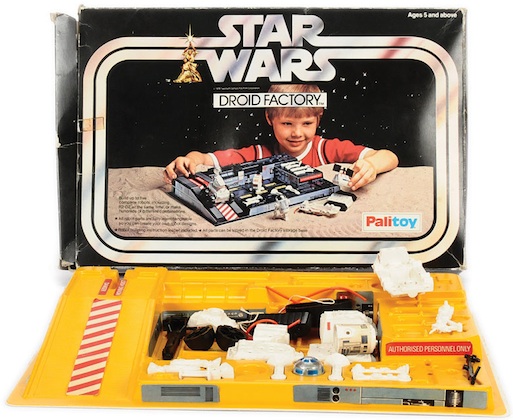 \ \The
blueprint instructions have the Palitoy logo in the bottom right hand
corner of the page and fold out to produce a large page four times the
size which is printed on both sides. On one side are instructions for
assembling droids called Mechano Droid, R2-D2 (with added middle leg),
Tracto-Droid, Quad-pod Droid, Rollarc Droid, Monster Droid, Droid 1,
Droid 2, Droid 3, Droid 4 and Droid 5. The other side has details for
where to store all the droid parts in the plastic tray (droid factory)
and where on the tray to place all the stickers on the sticker sheet.
There are also details how to assemble parts of the droids and how to
operate the winch. 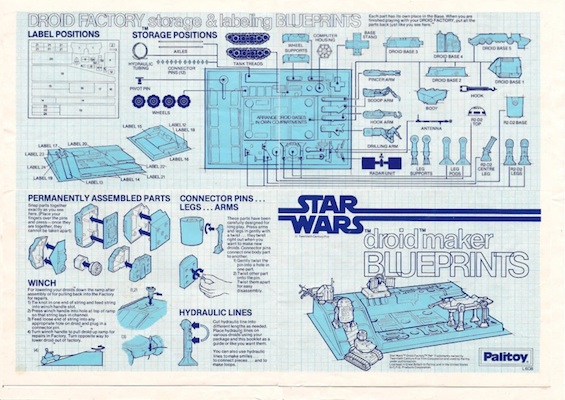 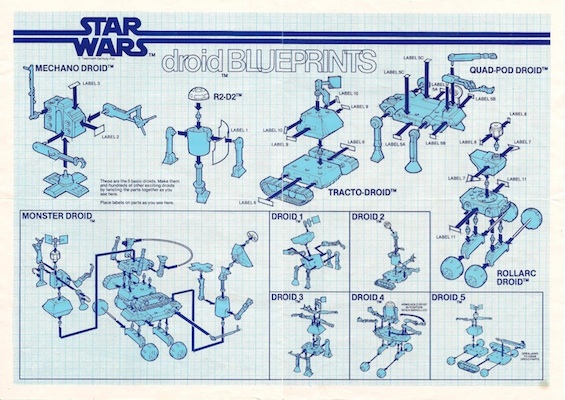 Land
of the Jawas was a playset centering round the Jawa Sand Crawler and
surrounding area. A flimsy yellow moulded plastic base supported by
cardboard was the desert area surrounding the Sand Crawler. The Sand
Crawler itself was 4 pieces of cardboard that clipped together to make
one side of the Sand Crawler. It also came with a lift assembly for
inside the Sand Crawler, two yellow plastic stands for placing figures
on, a duelling stand which 2 figures could fight on and a bagged Jawa
figure from the 3.75 inch figure range. It also came with Palitoy
branded instructions. The box featured a picture of the child playing
with the playset with the Palitoy logo in the bottom right hand corner.
The back of the box is the same as the front. There were several
differences from the Kenner version, designed to make it cheaper to
produce. The escape Pod that R2-D2 and C-3PO escaped in from the Tantive
IV is sadly missing, as is the indent on the front right of the plastic
base to hold it. The Kenner version also featured a cave for hiding
figures and an action lever which let Jawas capture R2-D2 which are not
present on the Palitoy version. Again, the Kenner plastic base is made
of sturdier plastic than the Palitoy version and is darker in colour.
The artwork on the Kenner box was also different because of all these
differences and featured a different child playing with the playset. 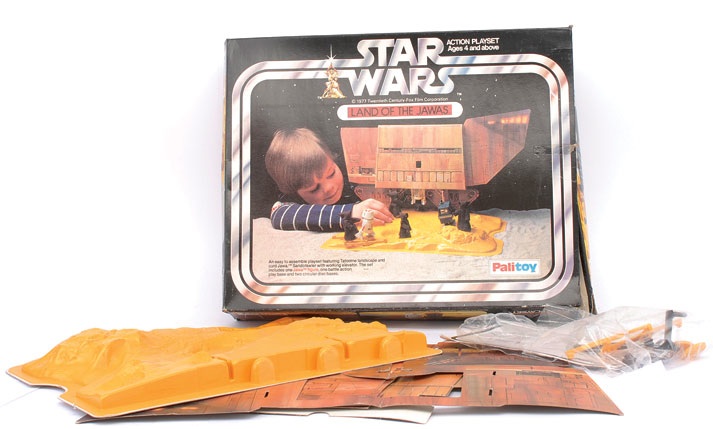 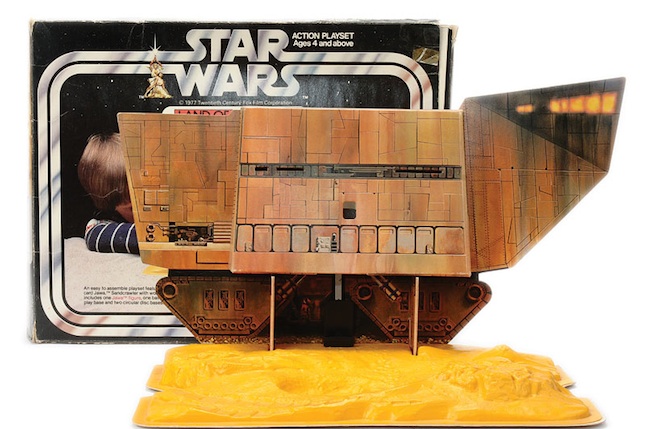 The
Palitoy instructions featured a sketch scene from the entrance of the
Sand Crawler and folded out to twice the size. The instructions inside
detail the included plastic parts and how to clip them together,
followed by a step by step guide for how to assemble the cardboard sand
crawler which extend onto the back page which has the Palitoy logo in
the bottom right hand corner. 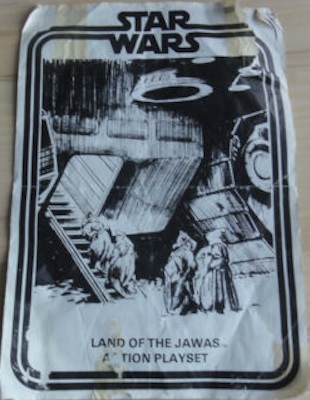 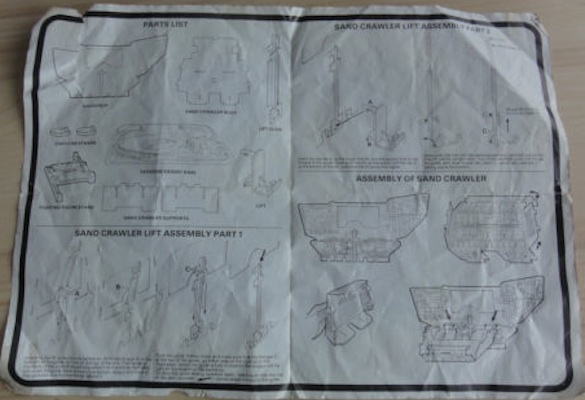  Catina
was a playset that centered round the Cantina bar In Mos Eisley. It
came with the now familiar yellow plastic base which was the floor of
the bar, a plastic door, the 2 plastic figure stands and duelling stand
that also came in Land of the Jawas, a plastic bar top and cardboard bar
door, bar front and back wall. It also came with Palitoy branded
instructions. The box features a child playing with the playset with the
Palitoy logo in the bottom right hand corner. The back of the box is
the same as the front. Again, Palitoy cut costs on the moulded plastic
base which is flimsier than the Kenner version. The duelling stand in
the Palitoy version is instead of the action levers which are
incorporated into the plastic base of the Kenner version. The bar is
lower on the Palitoy version but overall the playset is higher than the
Kenner version. The Kenner version had plastic bar doors and a plastic
bar front unlike the Palitoy version which had ones made from cardboard.
The steps on the right hand side of the playset are also different
between the two versions. The artwork on the Kenner box was different
and used a different child playing with the Kenner version of the
playset. Lastly, the Kenner version was called Creature Cantina Action
Playset, whereas the Palitoy version was simply called Cantina.   The
Palitoy playset also came with a special offer sticker which is rarer
than the non stickered version of the playset. The special offer
included 4 free action figures that featured inside the Cantina Bar.
These were Walrus Man, Hammerhead, Snaggletooth and Green Greedo, the
last of which was how Palitoy referred to this figure on various
products at that time. 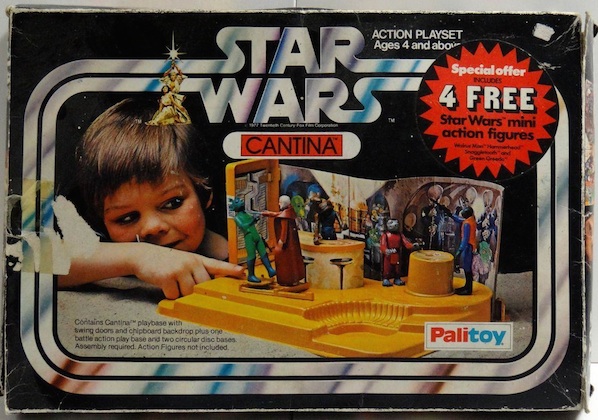 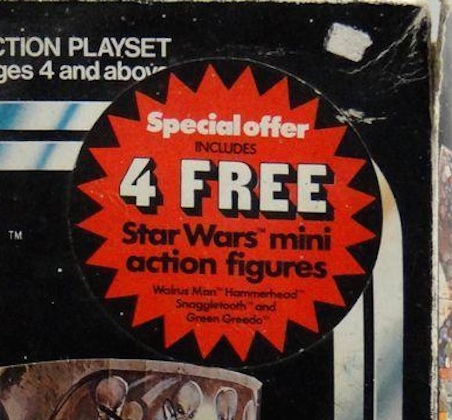 The
Palitoy instructions featured a sketch scene from inside the Cantina
Bar and folded out to twice the size. They were the same format as the
Land of Jawas instructions. The instructions inside detail the included
plastic parts and how to clip them together, followed by a step by step
guide for how to assemble the Cantina Bar which extend onto the back
page which has the Palitoy logo in the bottom right hand corner. 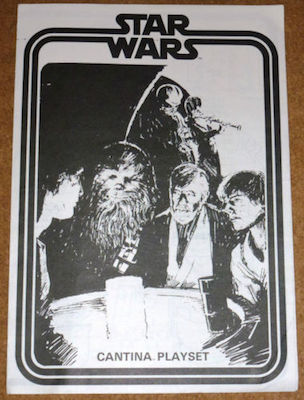 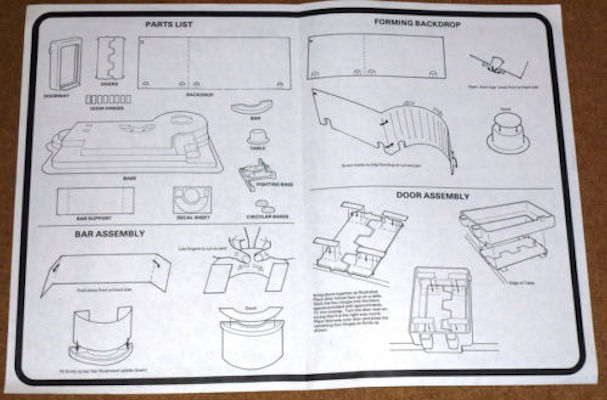 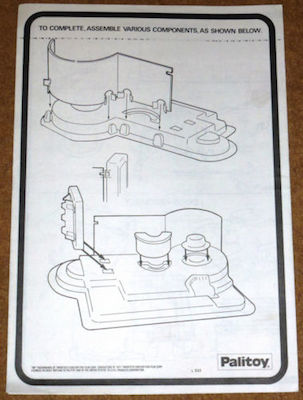 The
Palitoy version of the Death Star was completely different from the
Kenner version which was called the Death Star Space Station. The Kenner
version was a huge toy all made out of plastic which featured 4 levels
inside the Death Star in a small circle arc attached to a central core
with lift inside. This proved to be too costly a prospect for non
American toy companies to manufacture, and the Kenner version was only
sold in the USA and Canada. Palitoy's solution was to to make a half
sphere out of sturdy cardboard/chipboard material in flat pieces which
clipped together to form the half sphere. The half sphere was divided
into 2 levels with different rooms all the way round the circumference
of the sphere. This playset was cheap to produce and licensed to other
Toy manufacturers after being a big success for Palitoy. Meccano made a
version for the European market, Toltoys made Australian and New Zealand
versions, and even Kenner made a version which was sold in Canada. The
box artwork was identical on all these versions and featured a child in a
red sweater playing with the cardboard playset. One of the figures is a
vinyl cape Jawa as opposed to cloth cape. The Palitoy logo or other toy
manufacturers logo was in the bottom right hand corner of the box. The
back of the box featured 4 more pictures of the playset with action
figures in the rooms.   The
contents were the cardboard pieces that went together to make the half
sphere. These were attached to a large circular base and clipped
together using plastic clips. A pair of small plastic guns were attached
to the top of the sphere via a small black circular base. 6 clear
plastic figure stands were included for keeping figures upright inside
the playset. Lastly, Palitoy instructions and a Palitoy catalogue were
also included.  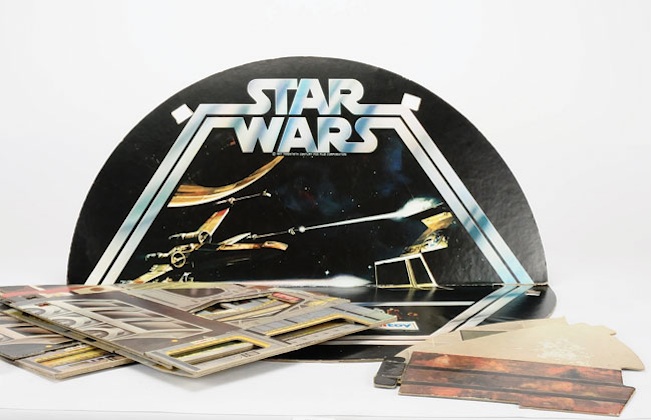 The
underside of the circular base featured a space fight scene between a
X-Wing Fighter and Tie Fighter. The first 12 actions figures (including
vinyl cape Jawa) are underneath this with the text 'Collect these 12
authentically designed figures, scaled to fit the Death Star'. In
practice it was the other way round, the Death Star was designed to fit
the figures! The assembled Death Star looked really impressive and it is
considered by many to be the best of the Star Wars playsets that
Palitoy produced.  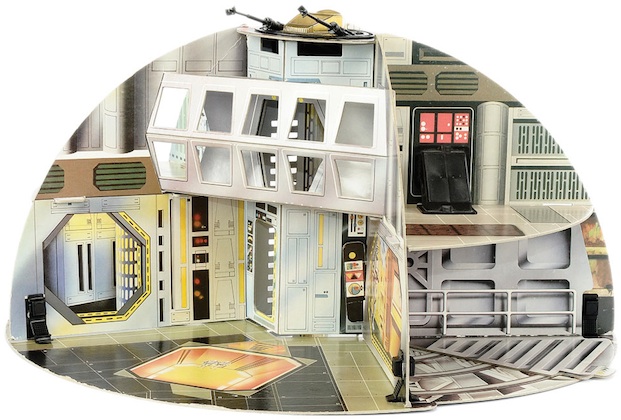 The
Palitoy instructions is a folded single sheet which is printed on both
sides. It details how to put together all the cardboard pieces that go
to make up the Death Star by using the enclosed plastic clips. The
Palitoy logo is in the bottom right hand corner on the back of the
sheet. A small Star Wars branded Palitoy catalogue which features the
same child in red sweater and the Death Star playset are on the cover of
this catalogue. The contents of this catalogue was a 10 page guide to
toys available in the Palitoy Star Wars range. 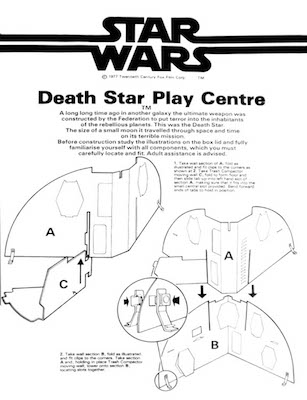   |
||
